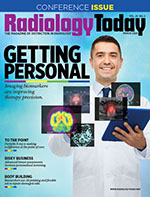 Imaging Informatics: The Key to Equity
Imaging Informatics: The Key to Equity
By Jordan Bazinsky
Radiology Today
Vol. 25 No. 2 P. 6
Having the finest health care resources at one’s fingertips doesn’t do much good if those resources aren’t used to help the world.
In health care, innovation is key, and the latest cutting-edge technologies equip care teams with solutions designed to efficiently preserve health and life. That means the lives of all patients. Overcoming health disparities has long been a challenge in the medical field, although strides have certainly been made toward addressing the structural inequities that restrict access and negatively impact outcomes for smaller segments of the population. Efforts to expand health equity are underway, and tools to help reach those goals are now readily available.
Imbalances leading to health equity challenges in radiology aren’t new, but they’ve recently garnered renewed attention thanks to reinvigorated efforts and calls for solutions. Many experts and leaders in the health care industry have acknowledged the topic’s resurgence and expect it will take on even more importance this year, especially as technology advancements and new solutions seem to be geared toward alleviating inequity. For example, doctors and radiologists are increasingly seeking imaging solutions that are portable and looking at ways to ensure quality care is never unavailable or delayed due to access obstacles.
Given the incredible leaps forward in radiology in recent years, it’s easier than ever to leverage these improvements to serve all patients—especially those who are most vulnerable and hardest to reach. Disadvantaged populations are disproportionately affected by preventable and treatable diseases due to lack of resources and access to care, but we’re in a position to change that.
A Global Exchange
For radiology to make an impact on the lives of those most in need, providers and care teams need faster access to data despite barriers such as cost, location, or staffing inadequacies. Fortunately, technology makes that possible, putting critical information and images in the hands of practitioners and clinicians with near immediacy.
The world’s largest medical image exchange network was created when Intelerad acquired image exchange provider Life Image in 2022. It provides health systems with a convenient solution for securely sending and receiving patient data. With over 18,000 image exchange network users connected around the globe, the ability to reach all areas and provide quality radiologic care to even the most remote areas is a reality and is being utilized thousands of times per day.
More overarching, comprehensive tools and solutions—geared toward embracing the big picture—are needed to make inroads toward health equity. Operating in silos does little good. Expanding the availability and quality of teleradiology, for example, is a move in the right direction. Patients who need screenings, such as a mammogram, MRI, or CT scan, don’t always have convenient access to these services and often can’t travel long distances to reach them. Radiology practices can take the lead in offering solutions to these problems.
Jan Eberth, PhD, interviewed for an article on care equity, is spot-on with her suggestions of offering transportation to screening centers, using mobile screening vans, and promoting screening through wellness days and time off to create more equitable access to health care.
Unlocking Equity
The Radiology Health Equity Coalition, convened by the ACR, has grown tremendously in the two years since its inception. Starting out with nine members, the coalition expanded to 26 in its first year and has now connected with over 40 major radiology organizations and community health partners to examine health care disparities in medical imaging. The coalition’s progress offers a clear indication that improving access to radiological patient care is an important focus and will be for some time. The ongoing support for the cause sets an encouraging tone and paves the way for others to follow suit and get involved.
The introduction of and participation in programs like this are critical if we’re to advance the notion of health equity and nurture an atmosphere conducive to its sustainability. Launching initiatives requires time, energy, and resources, which can be in short supply. Embracing the collaborative spirit, however, is an easier lift and can be as simple as helping with community-based participatory research and intersectional research frameworks. This was suggested by the authors of “Practical Approaches to Advancing Health Equity in Radiology,” published earlier this year in the American Journal of Roentgenology. Cooperation across geographies provides researchers with opportunities to build community partnerships and engage more of the radiology field’s top minds in colearning, thus aligning studies with objectives that support health equity.
Solutions of that variety, which are flexible and scalable, allow radiologists to adapt the frameworks to various settings suited to their capabilities and circumstances, making the efforts more fluid and increasing the chances of continuation. Additionally, international cooperation in support of a common goal—to address and eradicate health disparities— fosters trust and helps to ensure the involvement of diverse segments of the medical imaging industry.
By leveraging technology and working collaboratively to promote health equity across all populations, radiologists play an invaluable role in ensuring everyone has uncompromised access to quality medical care, regardless of location or financial status. The best practice here is the commitment of a determined and dedicated community of health care and health technology professionals to work together to improve patient outcomes across all demographics, genders, ages, races, and nationalities, no matter what challenges they face. Let’s work together to make positive health outcomes across the board the rule rather than the exception.
— Jordan Bazinsky is the CEO of Intelerad.

